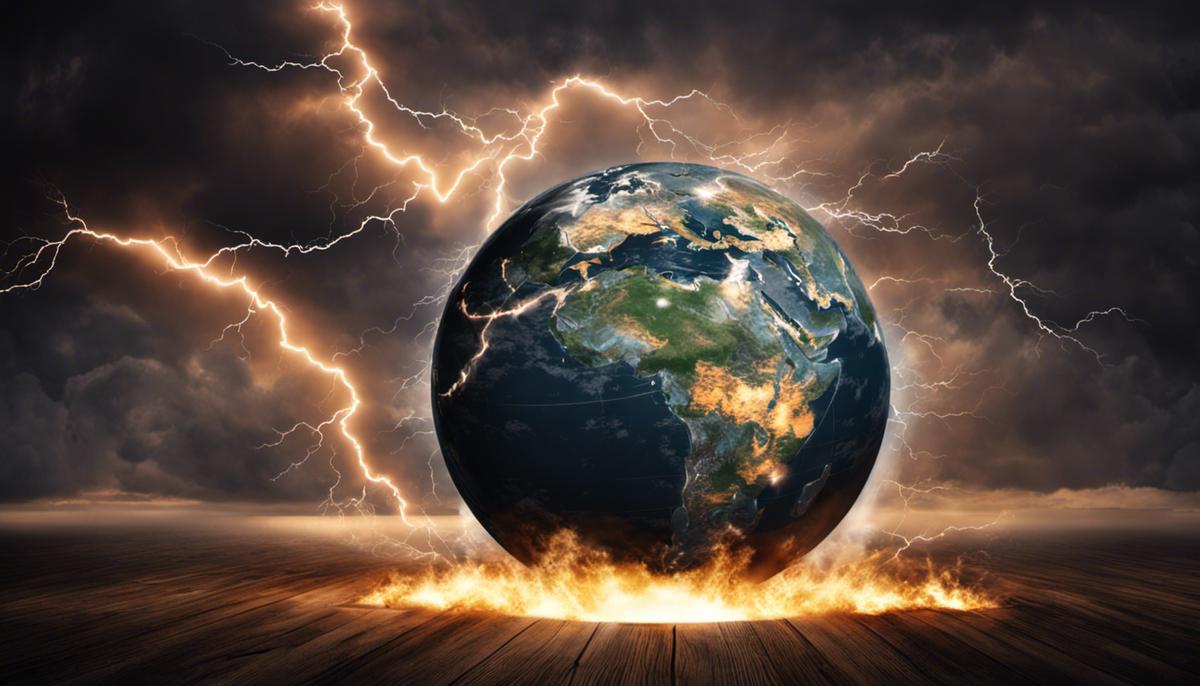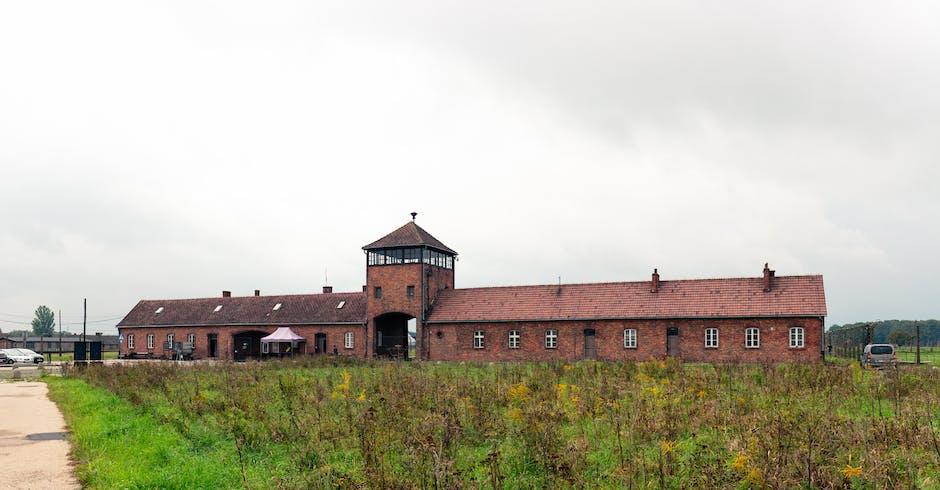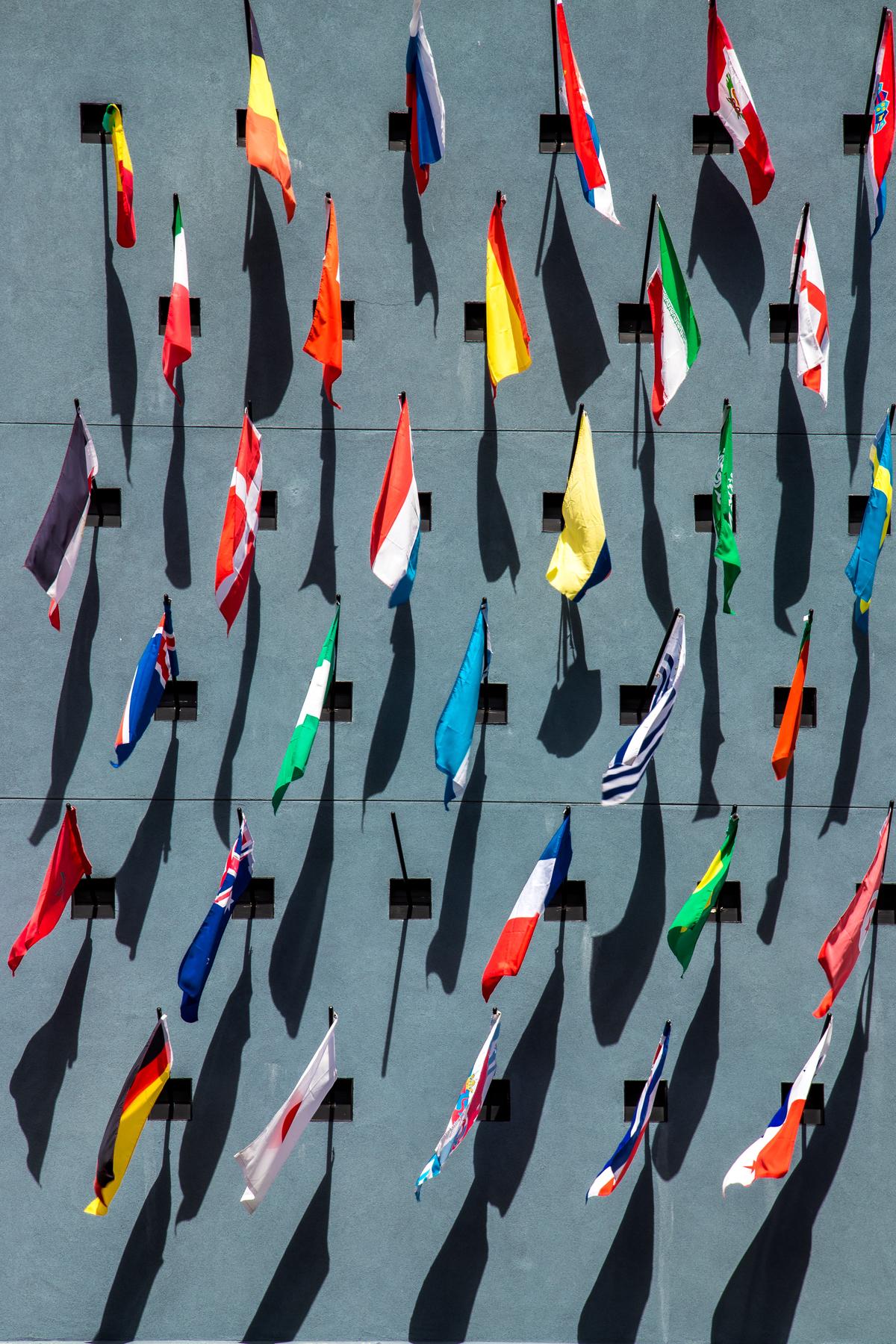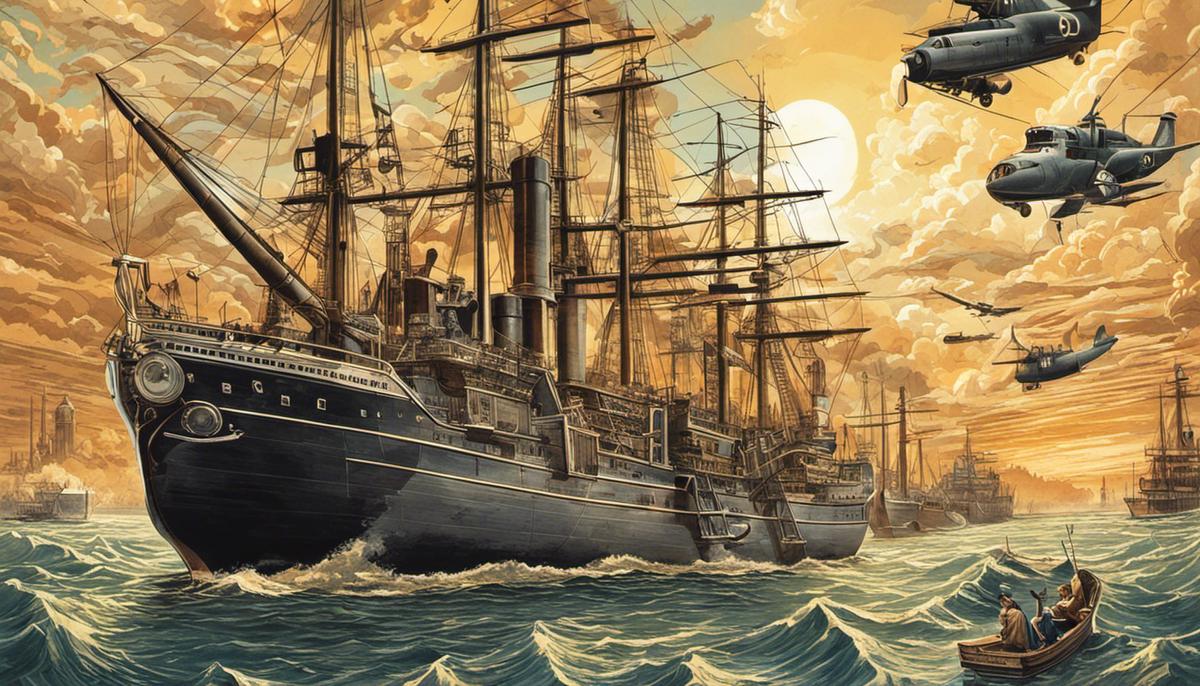The cataclysmic conflict that embroiled the globe from 1939 to 1945, known as World War II, didn’t sprout from a single, clear-cut origin. Rather, it was a complex web of precursors, a nexus of economic, political, ideological, and diplomatic factors that together cultivated an environment ripe for global discord. By interrogating these multifaceted causes behind the war – economic circumstances amplified by the Great Depression and the Treaty of Versailles reparations, the shifting political landscape with the detrimental rise of Fascism, the role of permeating ideologies of the time, and the faltering attempts at appeasement and diplomacy, we can gain a holistic understanding of the forces that ignited the fire of World War II.
Table of Contents
Economic Factors Leading to WWII
Global Economic Conditions and their Role in Initiating World War II
World War II was a geopolitical tornado, a tempest of violence and change that reshaped the global landscape. While a myriad of factors played into the incipience of this devastating conflict, a key player – the global economy – often remains sidelined. Indeed, the juxtaposition of economic landscapes provides us with a powerful tool in deciphering the complexities that propelled the world to war.
At the heart of the conflict was the unfavorable economic climate following World War I. The economic disruption brought on by this war was manifested through the Treaty of Versailles; a document technically meant to establish peace but ended up further doling out extensive economic burdens on the heavily afflicted Germany. Severe war reparations, territorial losses, and demilitarization imposed an austere economic climate leading to political instability, all of which prepared fertile ground for the rise of radical ideologies like National Socialism.
Meanwhile, across the Atlantic, the United States was enjoying a period of unprecedented economic prosperity during the 1920s, a stark contrast to war-debilitated Europe. However, the Wall Street Crash of 1929 rapidly changed this economic climate. The resultant Great Depression spread economic hardship globally, exacerbating existing economic struggles, and further straining international relations. Countries imposed import quotas and tariffs in a desperate bid to safeguard domestic industries, which subsequently hampered global trade and economic recovery.
The consequences of these economic downturns were potent. Countries which were economically vulnerable and politically disturbed were fertile ground for extremist ideologies to take hold. In Germany, the Nazis capitalized on the economic and national humiliation, propelling Adolf Hitler to power in 1933. They initiated aggressive expansionist policies, aiming to readjust the global economic scales in favor of Germany.
The catastrophic economic conditions in Japan paralleled those in Germany. The island nation was highly dependent on imports for raw materials and was heavily impacted by the decreased global trade following the Great Depression. Strongly influenced by the militarist sentiment of the time, Japan launched aggressive invasions into neighboring regions to secure resources, thereby escalating tensions in the Pacific.
However, it must be reiterated that global economic conditions do not stand alone. It is the interactions between the economy, political climate, societal sentiment, and diplomatic relations that create a complex, intertwined web leading up to global conflicts like World War II.
In conclusion, by delving into the pre-war global economic landscape, we gain new understandings of the myriad elements leading up to World War II. As we immerse ourselves into the past, we better comprehend the cascading effects of macroeconomic conditions, allowing us to not only study history but learn from it – an undertaking crucial to inform future policy and prevent the repeat of such destructive conflict.

Political Landscape Preceding WWII
While the cataclysm that was World War II holds its origins in a multitude of factors, the intricate interplay of politics, economics, and societal upheaval form the core features of its genesis. The political landscape that served as the playground for these phenomena presented a fertile ground for antagonism, thereby contributing significantly to the commencement of this horrific conflict.
Examining the international stage in detail, the profound disillusionment with the Establishment that was rampant in Europe crucially propelled the rise of radical ideologies. Politics, particularly in these countries that were economically crippled post World War I, bore a largely anti-establishment tint. A prime depiction was the evolution of Fascism under the charismatic dictatorship of Benito Mussolini in Italy. Garnering support mainly from the disenchanted middle class, despairing veterans, and nationalists, it spearheaded a prominent shift towards totalitarianism. Markedly, such a political shift echoed across several European nations, enlarging this fissure in the global political front.
Further emphasis must be laid on the insidious nature of appeasement politics that inadvertently played into the hands of fascist nations. Particularly in Britain and France, these policies aimed at pacifying the aggressive demands of Germany and Italy, to prevent another catastrophe akin to the first World War. Unfortunately, this strategy only served to embolden the totalitarian regimes, further destabilizing the political equilibrium and leading the world to the precipice of another global conflict.
Likewise, the Soviet Union emerged as a formidable entity under the iron fist of Joseph Stalin. The clandestine Molotov-Ribbentrop pact in 1939, stitching Nazi Germany and the USSR into a non-aggression agreement, was an unmistakable testament to the intricate power dynamics steering the pre-war politics. Cloaked in this deceit was Germany’s bid to circumnavigate a two-front war, and Stalin’s ephemeral buffer against German aggression.
Across the Atlantic, the U.S. adopted a largely isolationist stance focusing on the crisis at home. Yet, American policies had an indisputable reverberation on the international scene. To contend with the ravages of the Great Depression, the enactment of the Neutrality Acts placed restrictions on arms sales to warring countries, a decision bearing far-reaching consequences as tensions escalated.
In Asia, Japan’s ascension as a formidable militaristic power entailed a diversification of the political scenario. Its withdrawal from the League of Nations underscored the inadequacies of the international organization to rein in aggressive powers and underscored Japan’s disregard for collective security. This greatly emboldened their relentless pursuit of territorial conquest, leading to the rape of Nanking and the broader Sino-Japanese conflict, further exacerbating geopolitical tensions towards world war.
In conclusion, the political landscape preceding World War II was marred by misjudged diplomacy, the rise of totalitarian regimes, isolationist policies, and growing international tensions. This political tapestry, woven with the threads of unease, disillusionment, and antagonism, greatly shaped the trajectory of events, culminating in the horrendous conflagration that engulfed the globe. The understanding of this narrative underscores the critical role of wielding politics responsibly, to shield our world from embarking on a similar path of devastation.

Role of Ideologies in WWII
The rise of Fascism in Italy and National Socialism in Germany were emblematic of the internal political shifts that occurred as nations sought alternatives to liberal democracies. Political ideologies of extreme polarization such as Fascism and Communism tended to thrive at times of economic disparity and societal despair.
Fascism generated its strength from ultra-nationalistic sentiments, with an ideology that prioritized a harmonious homogeneous group over individuals’ rights or interests. Under the banner of Fascism, Italy stepped onto the world stage with aspiring visions of recovering its ancient glory as the seat of the Roman Empire. In Germany, the National Socialist German Workers’ Party, orchestrated by Adolf Hitler, emerged as a counter-reaction to the perceived humiliations meted out by the Treaty of Versailles. An intense anti-Semitic party, the Nazis accomplished a brilliant populist propaganda campaign employing national superiority and racial purity notions under the banner of Aryan supremacy.
The unfolding dynamics of appeasement politics further complicated the intricate political landscape. Fueled by an understandable wish to evade another calamitous war’s emergence, Western democracies, particularly France and Britain, pursued a passive strategy of appeasement towards the aggressive territorial ambitions of Germany and Italy. The insidious nature of appeasement allowed these aspirational powers to gain territorial footings without the immediate outbreak of hostilities, ultimately amplifying their capacities to wage war.
Adding another dimension to the geopolitical puzzle was the infamous Molotov-Ribbentrop pact of 1939. Aside from the treacherous guise of non-aggression, it provided a secret protocol dividing Eastern Europe into German and Soviet spheres of influence. This pact reflected a shared agenda of mutual non-interference between the two totalitarian regimes, each being able to pursue expansionist plans unobstructed. This temporary reprieve for the Soviet Union though was shattered by Operation Barbarossa in 1941.
Parallel to these narratives, across the Pacific Ocean, a wave of militaristic fervor swept Japan. Following its rapid industrialization, Japan embarked upon a militaristic quest for the acquisition of neighboring territories, most notably commencing a full-scale invasion of China – a prequel to its role in the World War II saga.
Meanwhile, on the western hemisphere, the United States clung to its isolationist stance, refraining from direct involvement in European affairs. The American Neutrality Acts of the mid-1930s were testament to this non-interventionist policy, allowing the US to avoid the infectious clouds of war. However, the strategic importance of the US could not be kept in check indefinitely, and its entry into the war following Pearl Harbor in 1941 became a pivotal moment that decisively shifted the balance of power.
From internal political shifts to international strategic blunders, the overtures to World War II were a multifaceted amalgam rooted in competing ideologies, aggressive exteriors, diplomatic failings, and political economic destabilization. The lessons imprinted by this tragic chapter of history serve to illumine the potential pitfalls inherent within the calculated dance of geopolitics, highlighting the perpetual need for responsible, informed action to safeguard global peace.

Appeasement and Failed Diplomacy
As the economic turmoil of the early 20th century further destabilized world politics, diplomacy – or the lamentable lack thereof – worked as an aggravator, setting the stage for World War II. The global community, represented by the League of Nations, grappled unsuccessfully with the creeping danger. The League, conceived to maintain peace post-World War I, demonstrated inherent structural flaws and collective diplomatic inertia, which contributed significantly to the genesis of World War II.
The League of Nations lacked universal participation – the absence of the United States underlined its inherent weaknesses, while the disinterest of the Soviet Union until 1934 further limited its potential efficacy. Decisions stemmed from unanimity, which made enforcement of resolutions problematic due to competing interests of member states.
Italy’s invasion of Ethiopia (1935-1936) showcased the League’s impotence. Despite condemning Italian aggression, the League failed to induce sanctions against Italy, prompting a reversal in the balance of power towards aggressor nations. This lack of effective consensus marked an abject failure of diplomacy, nudging the world closer to global conflict.
Simultaneously, the Appeasement policy adopted by Britain and France in the face of mounting German aggression further underscored diplomatic failure. Fueled by fear of confrontation and driven to avoid a repetition of the horrors of the Great War, Britain and France chose to appease Hitler, by granting him territories in hopes of preventing war. Notably, the Munich Agreement of 1938, which allowed German annexation of Czechoslovak territory, stands as an example of failed diplomacy, emboldening Hitler rather than satiating his territorial ambitions.
The role of the Molotov-Ribbentrop pact, signed in 1939 between the Soviet Union and Nazi Germany, in the build-up to World War II, yields further evidence of detrimental diplomatic measures. Through this pact, the two nations agreed to take a non-aggression stance towards each other, sealing the fate of Poland and other East European territories. This act of Orwellian diplomacy designed for self-preservation pushed Europe further into the abyss of war.
For the United States, the consequences of maintaining an isolationist stance until 1941 allowed simmering tensions to escalate. Domestically preoccupied and wary of international entanglement, the U.S. stood on the periphery of a destabilizing world order, thus allowing hostile nations to unilaterally redraw world boundaries unchecked.
World War II didn’t materialize in a vacuum; it was an effect of diplomatic failings, fueled by opportunistic power play, reluctance to direct confrontation, and avoidance of collective security responsibilities. The lessons of this tragic global devastation should continue to guide diplomacy in order to forestall such large-scale human tragedies in the future. May we always remember, neglecting the crucial role of diplomacy can carry a heavy price.

Our exploration into the causes of World War II has allowed us to peel back the layers of historical narrative and expose the intricate and multi-faceted influences that set the stage for the most devastating conflict in human history. It becomes clear through this analysis that the war was not a spontaneous event, but emerged from a confluence of economic turmoil, polarizing ideologies, political instability, and failed diplomatic efforts. Understanding these precursors not only elucidates the complexities of the historical period, but serves as a stark cautionary tale for the future. As we acknowledge the interconnectedness of these factors, we are reminded of the fragile nature of global harmony and how easily it can shatter in the hands of unchecked aggression, divisive politics, and escalating economic disparity.

Matt Smith is a seasoned journalist and author whose expertise spans across the dynamic realms of Politics, Gadgets, Gaming, and a plethora of general interest topics. With a Master’s in Political science and tech pedigree shaped in Silicon Valley, Matt brings a wealth of knowledge and a critical eye to everything he writes.
Politics: Matt offers sharp political commentary, drawing from his experience as a political analyst and his academic rigor.
Gadgets: His tech insights are grounded in real-world experience, having been on the front lines of innovation with a degree from Caltech.
Gaming: A respected voice in gaming, Matt’s reviews and trend analyses are a testament to his deep involvement in the gaming community.
General Topics: From science to culture, Matt’s writing spans a broad spectrum, engaging readers with a blend of expertise and relatable prose.
Engage with Matt’s compelling content for a fresh perspective on the issues at the forefront of today’s discourse.

